light JAGUAR XJ6 1994 2.G Owner's Manual
[x] Cancel search | Manufacturer: JAGUAR, Model Year: 1994, Model line: XJ6, Model: JAGUAR XJ6 1994 2.GPages: 521, PDF Size: 17.35 MB
Page 173 of 521
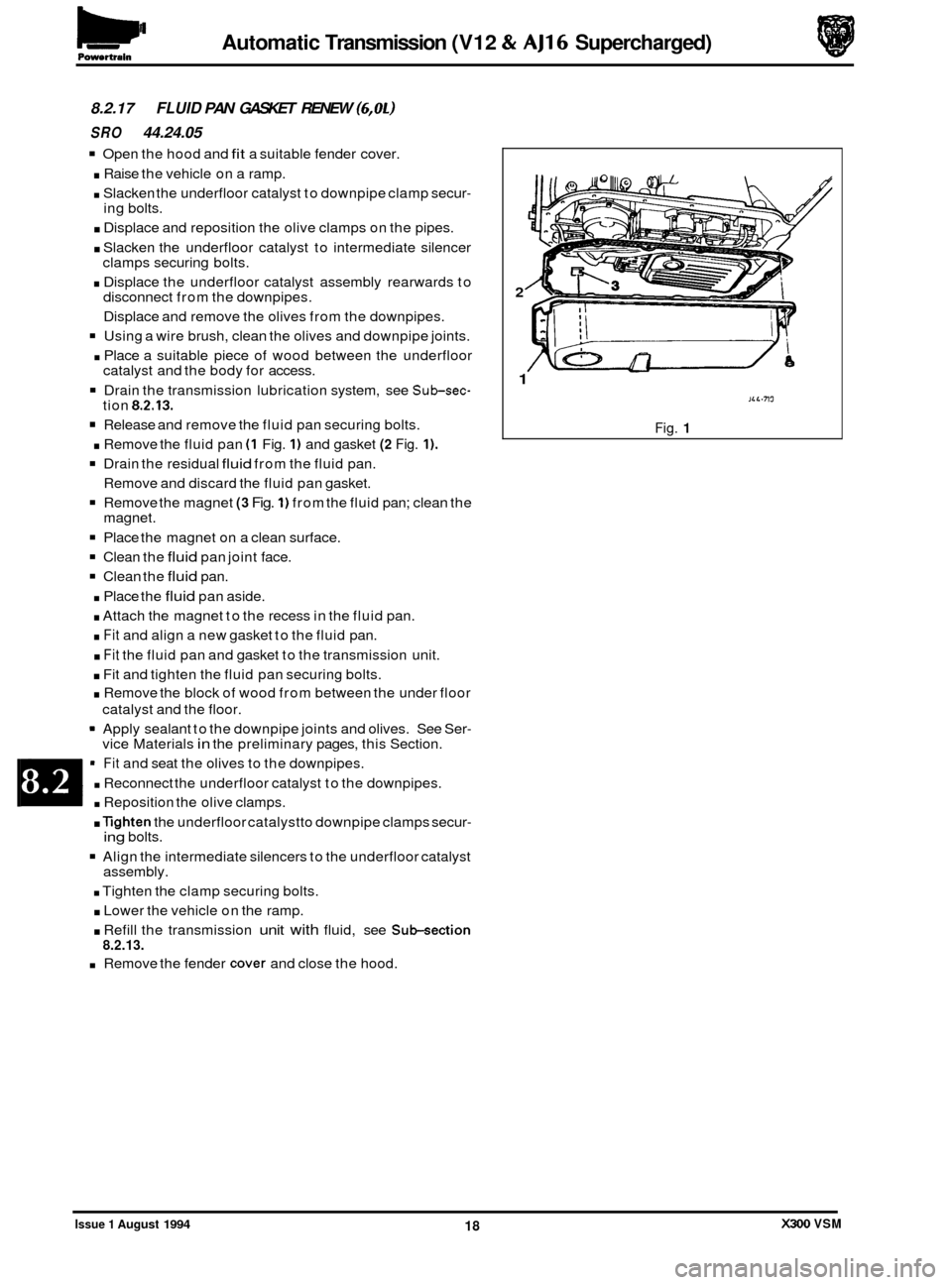
Automatic Transmission (V12 & AJ16 Supercharged) Powertrain
8.2.17 FLUID PAN GASKET RENEW (6,OL)
SRO 44.24.05
Open the hood and fit a suitable fender cover.
. Raise the vehicle on a ramp.
. Slacken the underfloor catalyst to downpipe clamp secur-
. Displace and reposition the olive clamps on the pipes.
. Slacken the underfloor catalyst to intermediate silencer
. Displace the underfloor catalyst assembly rearwards to
ing
bolts.
clamps securing bolts.
disconnect from the downpipes.
Displace and remove the olives from the downpipes.
Using a wire brush, clean the olives and downpipe joints.
. Place a suitable piece of wood between the underfloor
Drain the transmission lubrication system, see Sub-sec-
Release and remove the fluid pan securing bolts.
. Remove the fluid pan (1 Fig. 1) and gasket (2 Fig. 1).
Drain the residual fluid from the fluid pan.
Remove and discard the fluid pan gasket.
Remove the magnet (3 Fig. 1) from the fluid pan; clean the
magnet.
Place the magnet on a clean surface.
Clean the fluid pan joint face.
Clean the fluid pan.
. Place the fluid pan aside.
. Attach the magnet to the recess in the fluid pan.
. Fit and align a new gasket to the fluid pan.
. Fit the fluid pan and gasket to the transmission unit.
. Fit and tighten the fluid pan securing bolts.
. Remove the block of wood from between the under floor
catalyst and the floor.
9 Apply sealant to the downpipe joints and olives. See Ser- vice Materials in the preliminary pages, this Section.
= Fit and seat the olives to the downpipes.
. Reconnect the underfloor catalyst to the downpipes.
. Reposition the olive clamps.
. lighten the underfloor catalystto downpipe clamps secur-
Align the intermediate silencers to the underfloor catalyst
. Tighten the clamp securing bolts.
. Lower the vehicle on the ramp.
. Refill the transmission unit with fluid, see Sub-section 8.2.13.
Remove the fender cover and close the hood.
catalyst
and the body for access.
tion
8.2.13.
ing bolts.
assembly.
2
1
JLL.7K
Fig. 1
0
0
0
0
Issue 1 August 1994 18 X300 VSM
Page 208 of 521
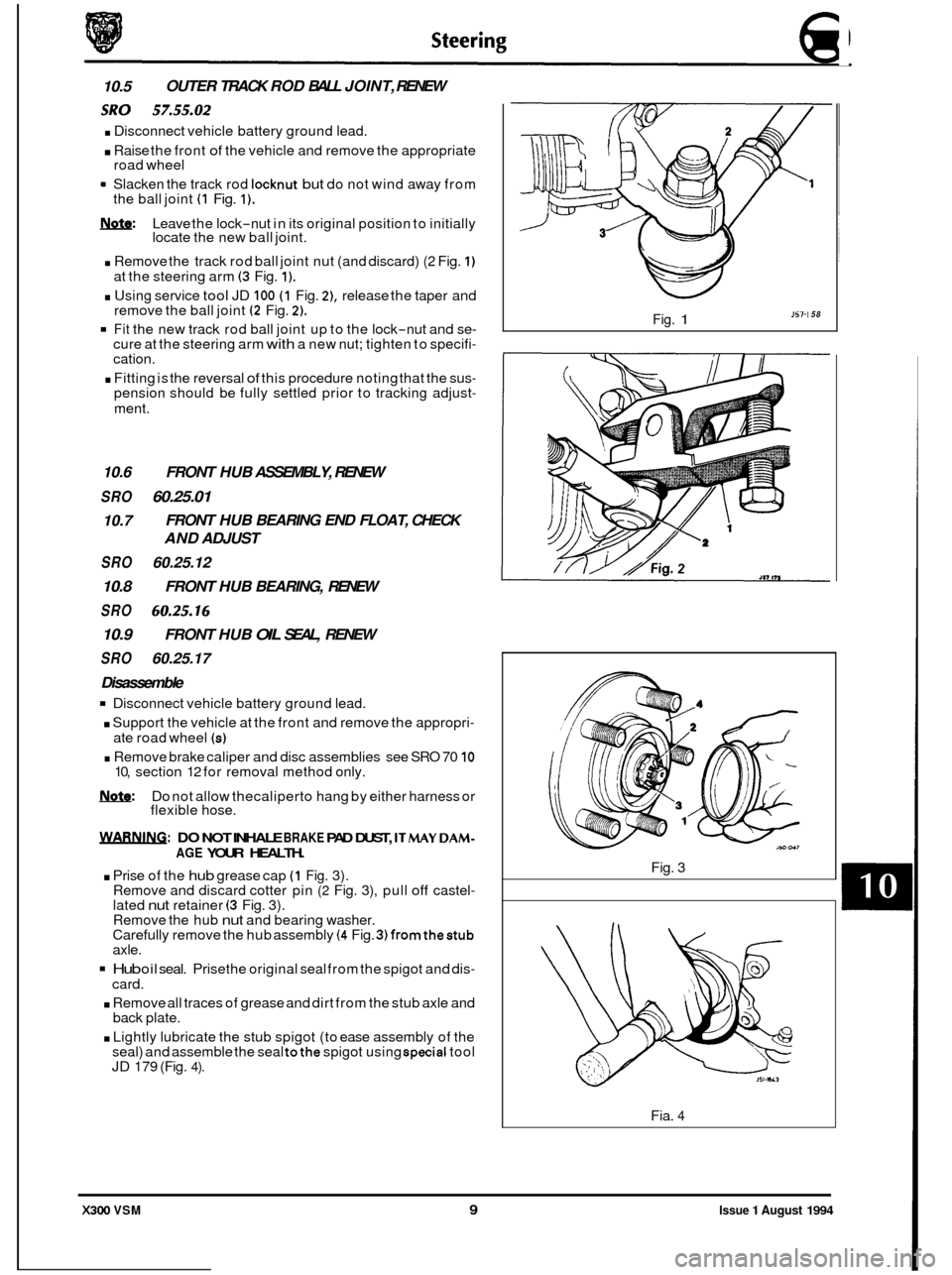
10.5 OUTER
TRACK ROD BALL JOINT, RENEW
sRo . Disconnect 57.55.02 vehicle battery ground lead.
. Raise the front of the vehicle and remove the appropriate
road wheel
Slacken the track rod
locknut but do not wind away from
the ball joint (1 Fig. 1).
m: Leave the lock-nut in its original position to initially
locate the new ball joint.
. Remove the track rod ball joint nut (and discard) (2 Fig. 1)
at the steering arm (3 Fig. 1).
. Using service tool JD 100 (1 Fig. 2), release the taper and
remove the ball joint (2 Fig. 2).
Fit the new track rod ball joint up to the lock-nut and se- cure at the steering arm with a new nut; tighten to specifi- cation.
. Fitting is the reversal of this procedure noting that the sus- pension should be fully settled prior to tracking adjust-
ment.
0 10.6 FRONT HUB ASSEMBLY, RENEW
SRO 60.25.01
10.7
SRO 60.25.12
10.8 FRONT HUB BEARING, RENEW
SRO 60.25.16
10.9
SRO 60.25.17
Disassemble
Disconnect vehicle battery ground lead.
. Support the vehicle at the front and remove the appropri-
. Remove brake caliper and disc assemblies see SRO 70 10
IWQ: Do not allow thecaliperto hang by either harness or
flexible hose.
FRONT HUB BEARING END FLOAT, CHECK
AND ADJUST
FRONT HUB
OIL SEAL, RENEW
ate road wheel (s)
10, section 12 for removal method only.
WARNIM: DO NOT INHALE BRAKE PAD DUST, ITMAY DAM-
0
AGE YOUR HEALTH.
. Prise of the hub grease cap (1 Fig. 3).
Remove and discard cotter pin (2 Fig. 3), pull off castel- lated nut retainer (3 Fig. 3).
Remove the hub nut and bearing washer.
Carefully remove the hub assembly (4 Fig. 3)fromthestub axle.
Hub oil seal. Prise the original seal from the spigot and dis-
card.
. Remove all traces of grease and dirt from the stub axle and
back plate.
. Lightly lubricate the stub spigot (to ease assembly of the
seal) and assemble the seal tothe spigot using special tool JD 179 (Fig. 4).
JS7-i 58 Fig. 1
Fig. 3
Fia.
4
X300 VSM 9 Issue 1 August 1994
Page 209 of 521

@ Steering
. Pack the annular gaps of the oil seal lips with grease.
. Bearing. Wash the hub assembly thoroughly and 'drift' the affected bearing cup(s) from the hub.
!&!$Q:
rn Hub. At this point the hub may be renewed if required.
Assembly
. Bearing. Assemble the inner bearing track to the hub using service tool 18G 134 and adaptor JD 550 - 5 / 1.
Ensure that the hub inner seal diameter is free of debris or damage and is lightly lubricated prior to assembly.
Only replace complete bearings, never cup or race in isolation.
Assemble the outer bearing cup to the hub using service tool
18G 134 and adaptor JD 550 - 5 / 2. Pack each race with approximately 4 ml of grease and position the inner race onto the stub axle.
Apply a smear of grease to hub inner surfaces and bearing cups. Assemble the hub to the stub axle followed by
outer race, bearing washer and hub nut.
It is not necessary to fill the hub cavity with grease, merely protect from corrosion with a coat of IubricanL'Seat'the bear-
ings by slightly tightening the hub nut whilst rotating the hub. Do not apply load without rotation. m:
. End float. Set a Dial Test Indicator (DTI) as shown in Fig. 1 and adjust the hub nut to achieve the correct end float.
As the adjustment is made, continually load the hub axial-
ly in both directions.
. Without disturbing the end float setting, fit the castellated
nut retainer so that it aligns with both hub nut and stub
axle drilling.
. Secure nut retainer using a new cotter pin.
9 Assembly and fitting is the reversal of this procedure not- ing that; all fixings MUST be tightened to specification
and operation of the braking system verified.
Fig. 1
Issue 1 August 1994 10 X300 VSM
Page 217 of 521
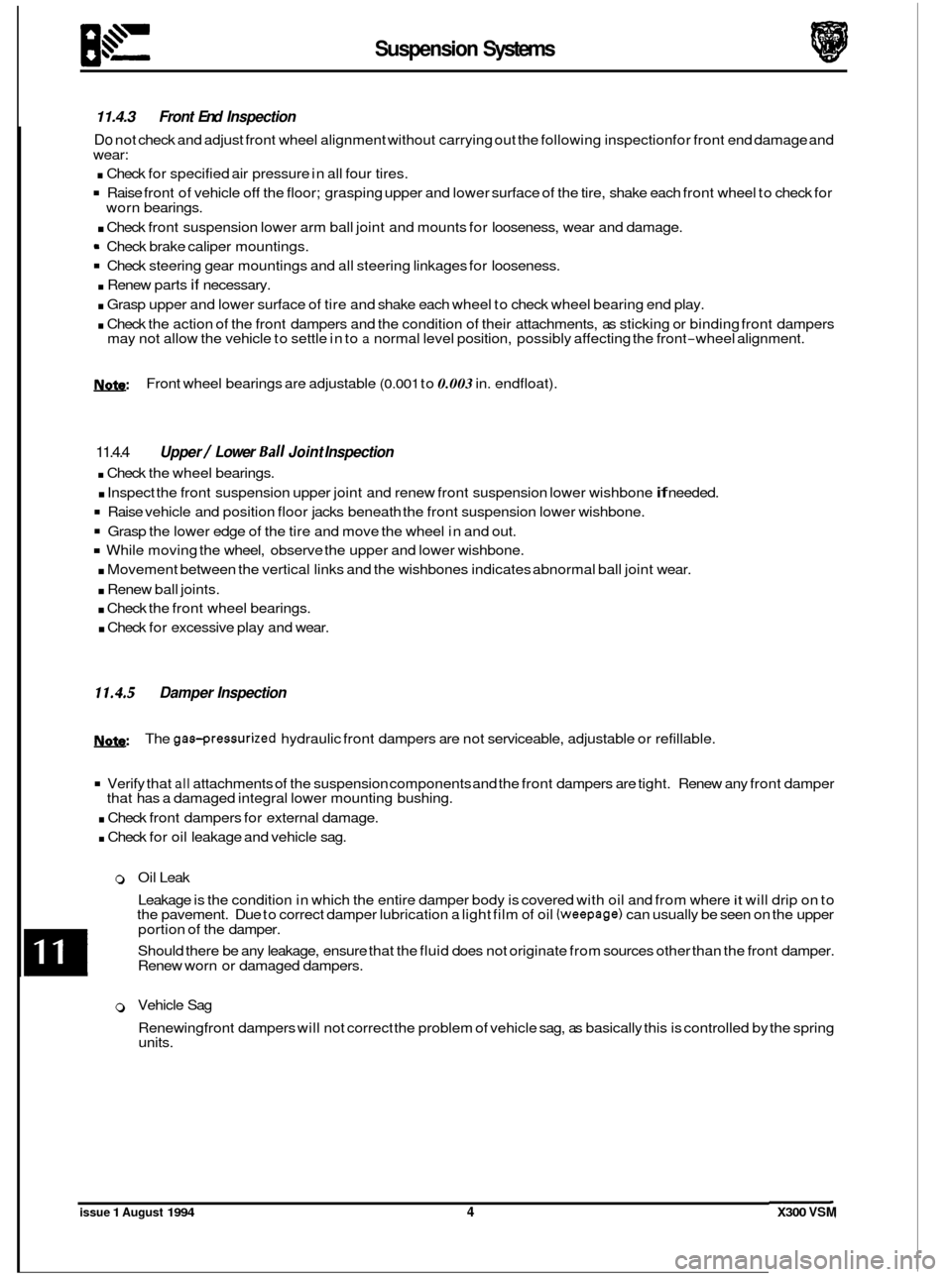
Suspension Systems
11.4.3 Front End Inspection
Do not check and adjust front wheel alignment without carrying out the following inspection for front end damage and
wear:
. Check for specified air pressure in all four tires.
Raise front of vehicle off the floor; grasping upper and lower surface of the tire, shake each front wheel to check for
. Check front suspension lower arm ball joint and mounts for looseness, wear and damage.
Check steering gear mountings and all steering linkages for looseness.
. Renew parts if necessary.
. Grasp upper and lower surface of tire and shake each wheel to check wheel bearing end play.
. Check the action of the front dampers and the condition of their attachments, as sticking or binding front dampers
worn
bearings.
Check brake caliper mountings.
may not allow the vehicle to settle in to a normal level position, possibly affecting the front-wheel alignment.
m: Front wheel bearings are adjustable (0.001 to 0.003 in. endfloat).
11.4.4
. Check the wheel bearings.
. Inspect the front suspension upper joint and renew front suspension lower wishbone if needed.
Raise vehicle and position floor jacks beneath the front suspension lower wishbone.
Grasp the lower edge of the tire and move the wheel in and out.
While moving the wheel, observe the upper and lower wishbone.
. Movement between the vertical links and the wishbones indicates abnormal ball joint wear.
. Renew ball joints.
. Check the front wheel bearings.
. Check for excessive play and wear.
Upper / Lower Ball Joint Inspection
11.4.5 Damper Inspection
m: The gas-pressurized hydraulic front dampers are not serviceable, adjustable or refillable.
Verify that all attachments of the suspension components and the front dampers are tight. Renew any front damper
. Check front dampers for external damage.
. Check for oil leakage and vehicle sag.
that
has a damaged integral lower mounting bushing.
0 Oil Leak
Leakage is the condition in which the entire damper body is covered with oil and from where
it will drip on to
the pavement. Due to correct damper lubrication a light film of oil (weepage) can usually be seen on the upper
portion of the damper.
Should there be any leakage, ensure that the fluid does not originate from sources other than the front damper.
Renew worn or damaged dampers.
0 Vehicle Sag
Renewing front dampers will not correct the problem of vehicle sag, as basically this is controlled by the spring
units.
issue 1 August 1994 4 X300 VSM
Page 224 of 521
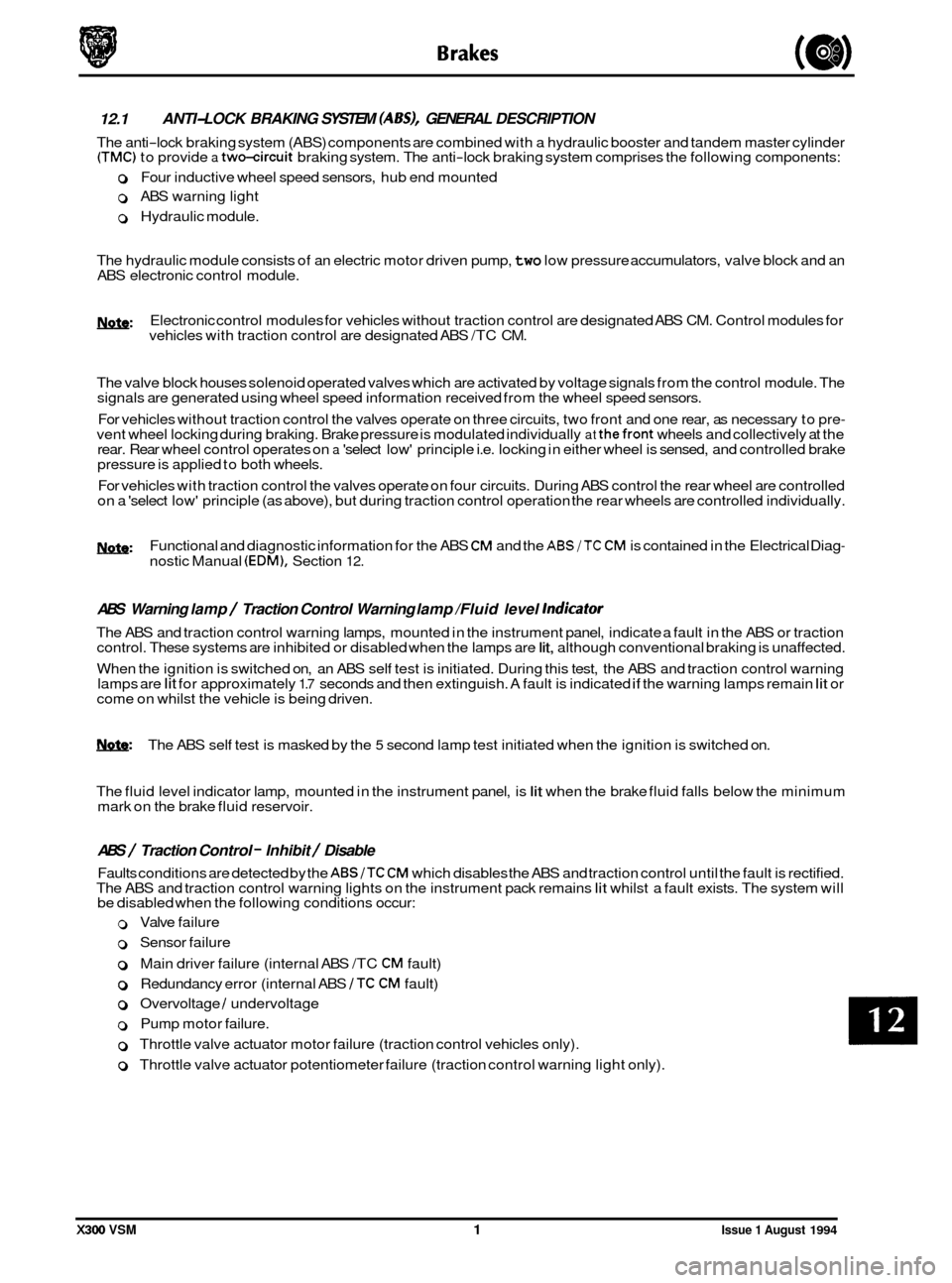
12.1 ANTI-LOCK BRAKING SYSTEM (ASS), GENERAL DESCRIPTION
The anti-lock braking system (ABS) components are combined with a hydraulic booster and tandem master cylinder (TMC) to provide a two-circuit braking system. The anti-lock braking system comprises the following components:
0 Four inductive wheel speed sensors, hub end mounted
0 ABS warning light
0 Hydraulic module.
The hydraulic module consists of an electric motor driven pump,
two low pressure accumulators, valve block and an
ABS electronic control module.
m: Electronic control modules for vehicles without traction control are designated ABS CM. Control modules for
vehicles with traction control are designated ABS /TC CM.
The valve block houses solenoid operated valves which are activated by voltage signals from the control module. The
signals are generated using wheel speed information received from the wheel speed sensors.
For vehicles without traction control the valves operate on three circuits, two front and one rear, as necessary to pre
- vent wheel locking during braking. Brake pressure is modulated individually at thefront wheels and collectively at the
rear. Rear wheel control operates on a 'select low' principle i.e. locking in either wheel is sensed, and controlled brake
pressure is applied to both wheels.
For vehicles with traction control the valves operate on four circuits. During ABS control the rear wheel are controlled
on a 'select low' principle (as above), but during traction control operation the rear wheels are controlled individually.
0
1yQfB: Functional and diagnostic information for the ABS CM and the ABS/TC CM is contained in the Electrical Diag-
nostic Manual (EDM), Section 12.
ABS Warning lamp / Traction Control Warning lamp /Fluid level Indicator
The ABS and traction control warning lamps, mounted in the instrument panel, indicate a fault in the ABS or traction
control. These systems are inhibited or disabled when the lamps are lit, although conventional braking is unaffected.
When the ignition is switched on, an ABS self test is initiated. During this test, the ABS and traction control warning
lamps are
lit for approximately 1.7 seconds and then extinguish. A fault is indicated if the warning lamps remain lit or
come on whilst the vehicle is being driven.
W: The ABS self test is masked by the 5 second lamp test initiated when the ignition is switched on.
The fluid level indicator lamp, mounted in the instrument panel, is
lit when the brake fluid falls below the minimum
mark on the brake fluid reservoir.
ABS / Traction Control - Inhibit / Disable
Faults conditions are detected by the ABS/TC CM which disables the ABS and traction control until the fault is rectified.
The ABS and traction control warning lights on the instrument pack remains lit whilst a fault exists. The system will
be disabled when the following conditions occur:
0
0 Valve failure
0 Sensor failure
0 Main driver failure (internal ABS /TC CM fault)
0 Redundancy error (internal ABS JTC CM fault)
0 Overvoltage J undervoltage
0 Pump motor failure.
0 Throttle valve actuator motor failure (traction control vehicles only).
0 Throttle valve actuator potentiometer failure (traction control warning light only).
X300 VSM 1 Issue 1 August 1994
Page 225 of 521
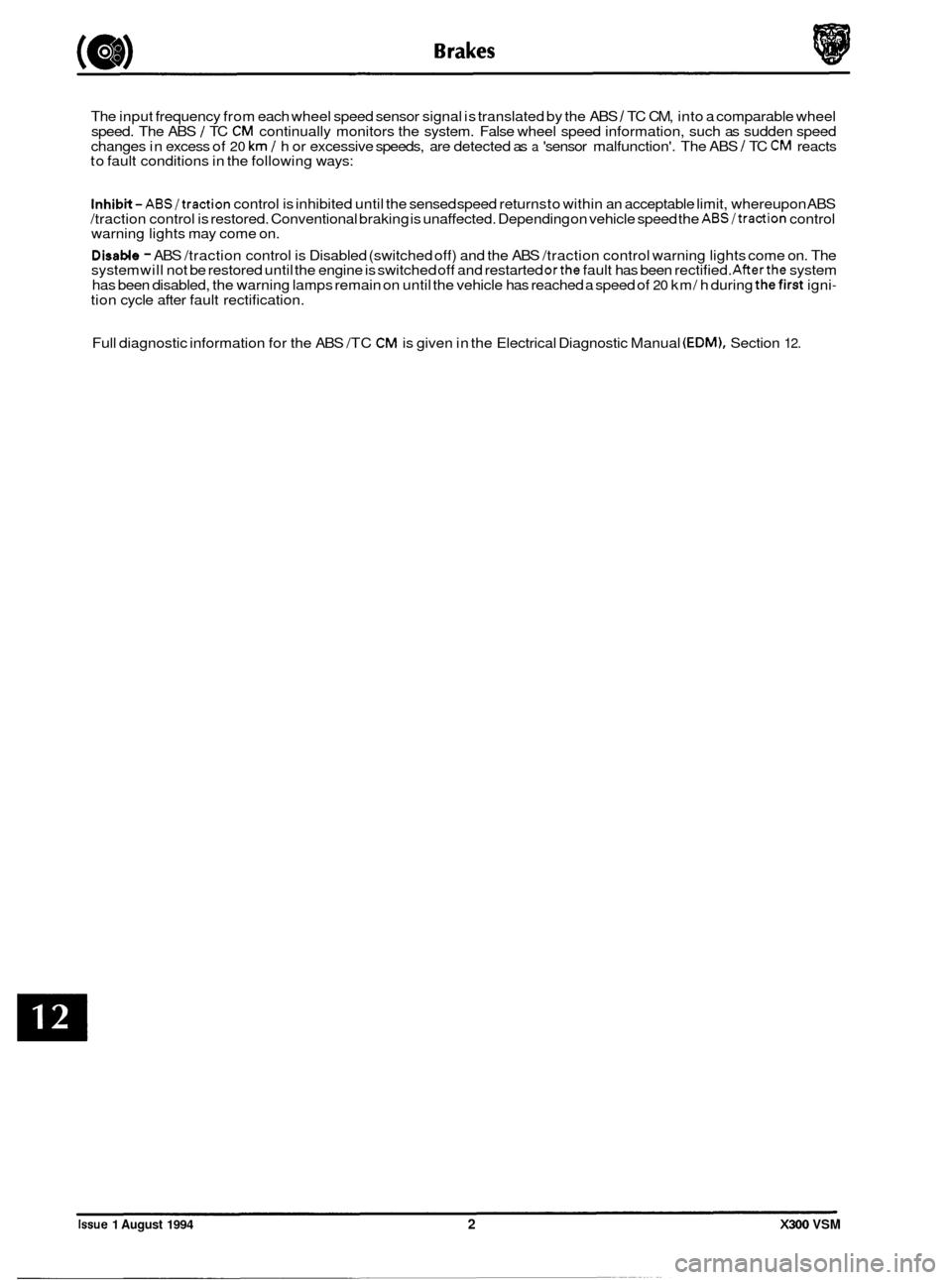
The input frequency from each wheel speed sensor signal is translated by the ABS I TC CM, into a comparable wheel
speed. The ABS / TC CM continually monitors the system. False wheel speed information, such as sudden speed
changes in excess of 20 km / h or excessive speeds, are detected as a 'sensor malfunction'. The ABS / TC CM reacts
to fault conditions in the following ways:
Inhibit- ABS/traction control is inhibited until the sensed speed returns to within an acceptable limit, whereupon ABS
/traction control is restored. Conventional braking is unaffected. Depending on vehicle speed the ABS/traction control
warning lights may come on.
DisaMe - ABS /traction control is Disabled (switched off) and the ABS /traction control warning lights come on. The
system will not be restored until the engine is switched off and restarted orthe fault has been rectified. Afterthe system
has been disabled, the warning lamps remain on until the vehicle has reached a speed of 20 km/ h during thefirst igni- tion cycle after fault rectification.
Full diagnostic information for the ABS /TC
CM is given in the Electrical Diagnostic Manual (EDM), Section 12.
Issue 1 August 1994 2 X300 VSM
Page 229 of 521
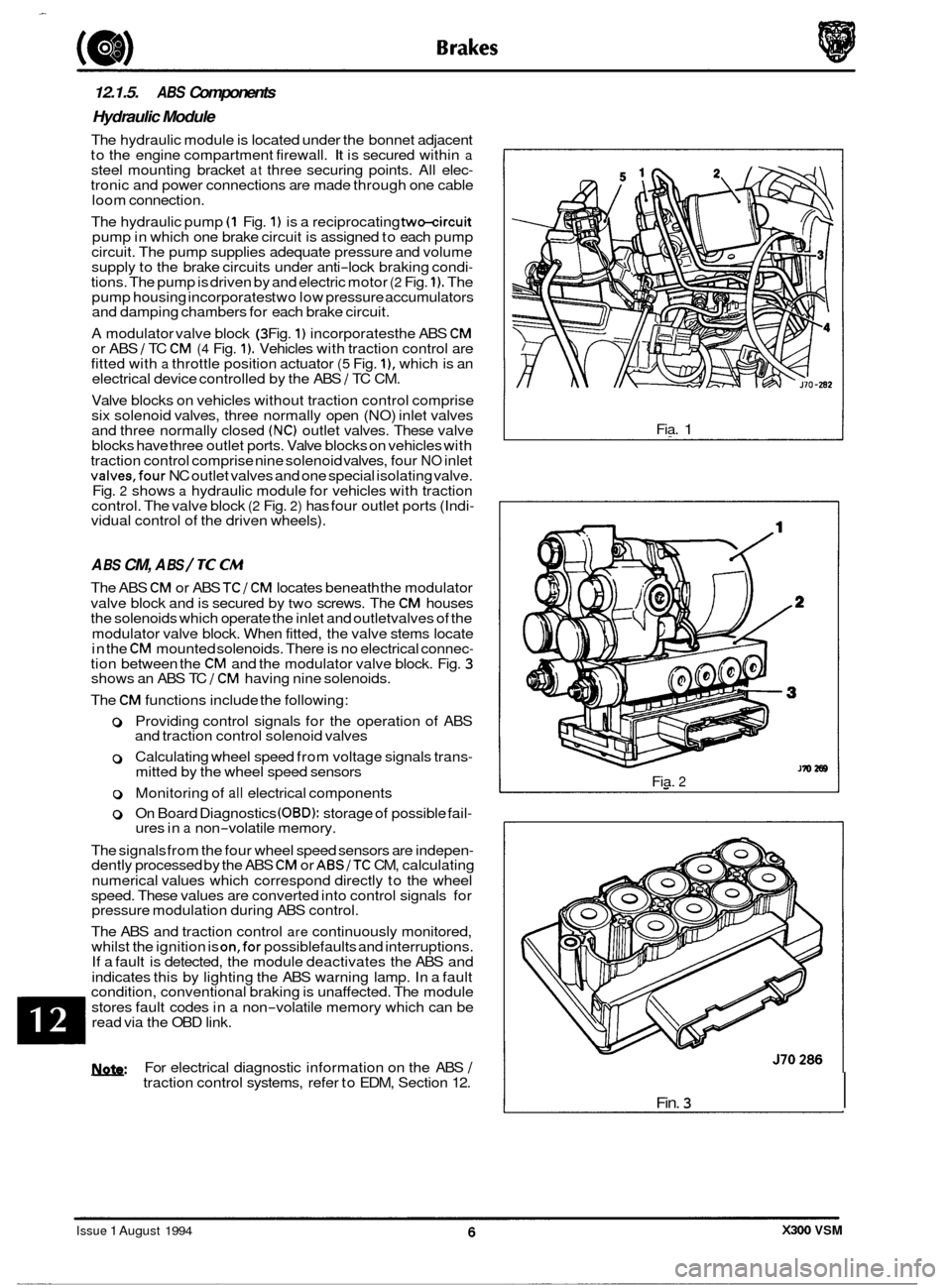
12.1.5. ABS Components
Hydraulic Module
The hydraulic module is located under the bonnet adjacent
to the engine compartment firewall. It is secured within a steel mounting bracket at three securing points. All elec- tronic and power connections are made through one cable
loom connect ion.
The hydraulic pump
(1 Fig. 1) is a reciprocating two-circuit pump in which one brake circuit is assigned to each pump
circuit. The pump supplies adequate pressure and volume
supply to the brake circuits under anti
-lock braking condi- tions. The pump is driven by and electric motor (2 Fig. 1). The
pump housing incorporates two low pressure accumulators
and damping chambers for each brake circuit.
A modulator valve block
(3 Fig. 1) incorporates the ABS CM or ABS / TC CM (4 Fig. 1). Vehicles with traction control are
fitted with a throttle position actuator (5 Fig. I), which is an
electrical device controlled by the ABS 1 TC CM.
Valve blocks on vehicles without traction control comprise
six solenoid valves, three normally open (NO) inlet valves
and three normally closed
(NC) outlet valves. These valve
blocks have three outlet ports. Valve blocks on vehicles with
traction control comprise nine solenoid valves, four
NO inlet valves,four NC outlet valves and one special isolating valve.
Fig. 2 shows a hydraulic module for vehicles with traction
control. The valve block (2 Fig. 2) has four outlet ports (Indi- vidual control of the driven wheels).
A BS CM, A BS / TC CM
The ABS CM or ABS TCI CM locates beneath the modulator
valve block and is secured by
two screws. The CM houses
the solenoids which operate the inlet and outletvalves of the
modulator valve block. When fitted, the valve stems locate
in the
CM mounted solenoids. There is no electrical connec- tion between the CM and the modulator valve block. Fig. 3 shows an ABS TC 1 CM having nine solenoids.
The
CM functions include the following:
0 Providing control signals for the operation of ABS
and traction control solenoid valves
0 Calculating wheel speed from voltage signals trans- mitted by the wheel speed sensors
0 Monitoring of all electrical components
0 On Board Diagnostics (OBD): storage of possible fail- ures in a non-volatile memory.
The signals from the four wheel speed sensors are indepen
- dently processed by the ABS CM or ABSITC CM, calculating
numerical values which correspond directly to the wheel
speed. These values are converted into control signals for
pressure modulation during ABS control.
The ABS and traction control
are continuously monitored,
whilst the ignition is on,for possiblefaults and interruptions.
If a fault is detected, the module deactivates the ABS and
indicates this by lighting the ABS warning lamp. In a fault
condition, conventional braking is unaffected. The module
stores fault codes in a non
-volatile memory which can be
read via the OBD link.
U: For electrical diagnostic information on the ABS I traction control systems, refer to EDM, Section 12. Fia.
1
Fia. 2
Fin. 3 I
J70286
Issue 1 August 1994 X300 VSM
Page 232 of 521
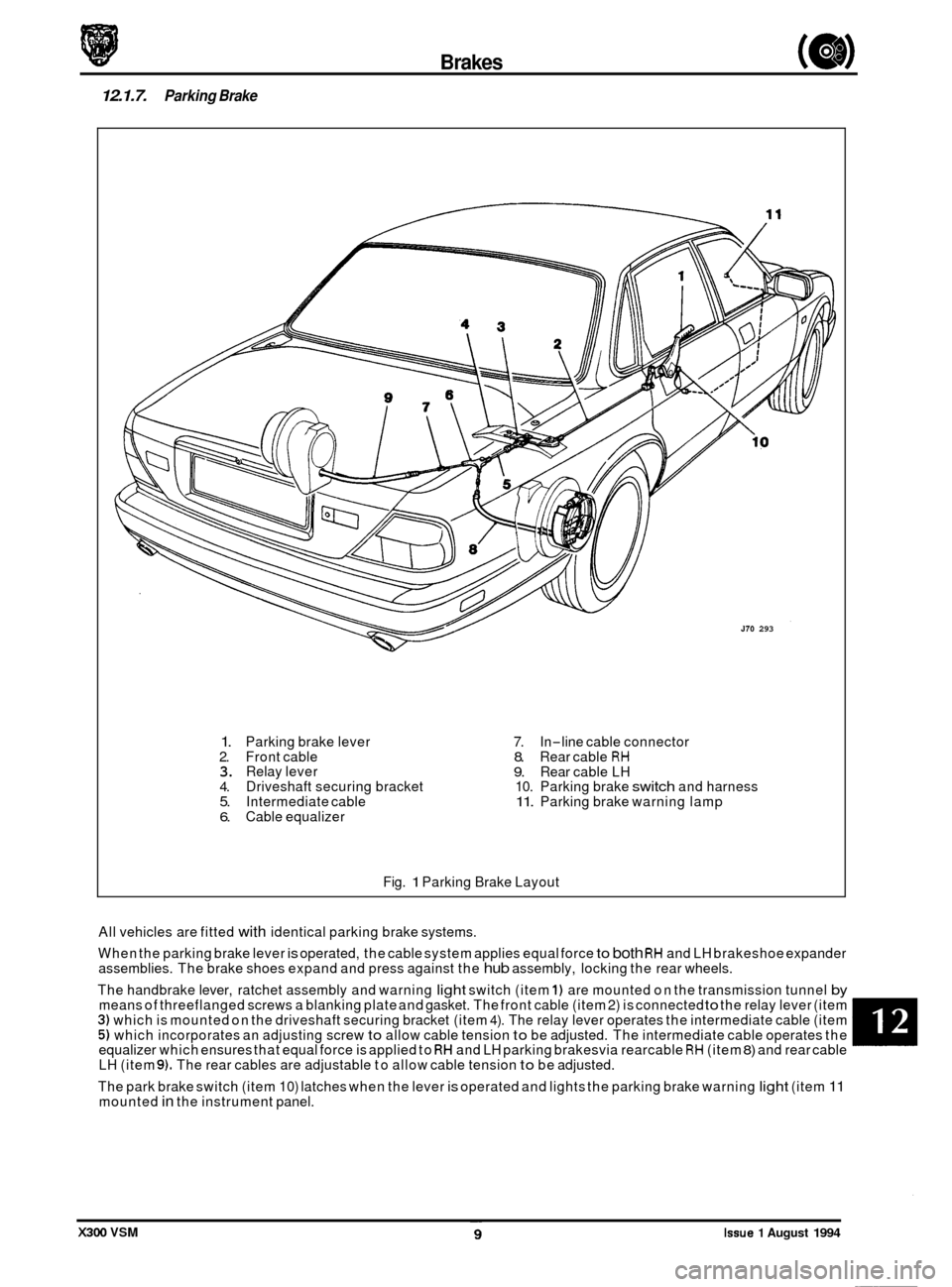
Brakes (e#
12.1.7. Parking Brake
J70 293
W
1. Parking brake lever 2. Front cable 3. Relay lever 4. Driveshaft securing bracket 5. Intermediate cable 6. Cable equalizer
7. In-line cable connector 8. Rear cable RH 9. Rear cable LH
10. Parking brake switch and harness 11. Parking brake warning lamp
Fig.
1 Parking Brake Layout
All vehicles are fitted with identical parking brake systems.
When the parking brake lever
is operated, the cable system applies equal force to both RH and LH brakeshoe expander
assemblies. The brake shoes expand and press against the hub assembly, locking the rear wheels.
The handbrake lever, ratchet assembly and warning
light switch (item 1) are mounted on the transmission tunnel by means of threeflanged screws a blanking plate and gasket. The front cable (item 2) is connected to the relay lever (item 3) which is mounted on the driveshaft securing bracket (item 4). The relay lever operates the intermediate cable (item 5) which incorporates an adjusting screw to allow cable tension to be adjusted. The intermediate cable operates the
equalizer which ensures that equal force is applied to RH and LH parking brakesvia rearcable RH (item 8) and rear cable
LH (item 9). The rear cables are adjustable to allow cable tension to be adjusted.
The park brake switch (item 10) latches when the lever
is operated and lights the parking brake warning light (item 11 mounted in the instrument panel.
X300 VSM Issue 1 August 1994
Page 233 of 521
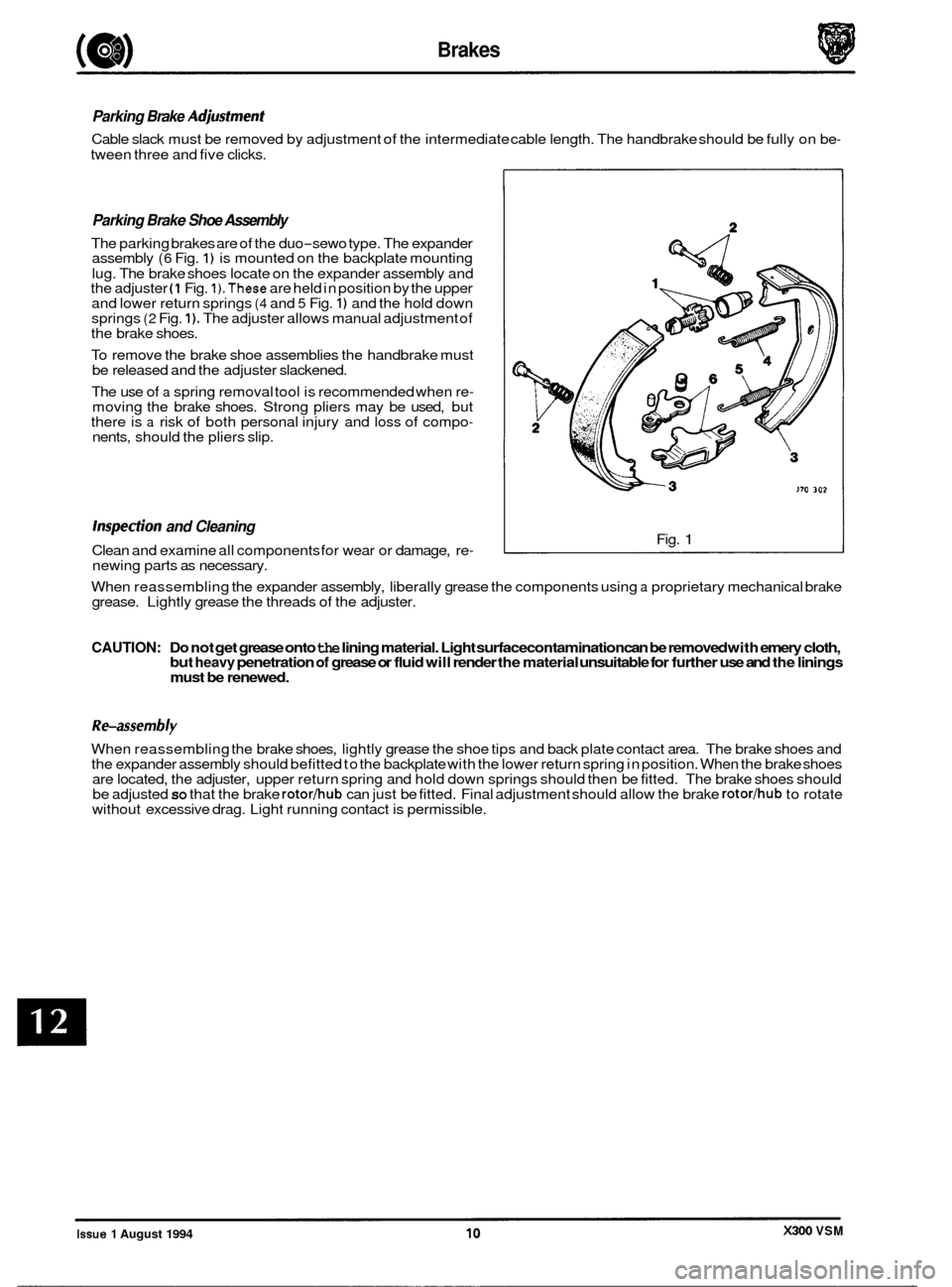
Brakes
Parking Brake Adjusfmenf
Cable slack must be removed by adjustment of the intermediate cable length. The handbrake should be fully on be-
tween three and five clicks.
Parking Brake Shoe Assembly
The parking brakes are of the duo-sewo type. The expander
assembly (6 Fig. 1) is mounted on the backplate mounting
lug. The brake shoes locate on the expander assembly and
the adjuster
(1 Fig. I).These are held in position by the upper
and lower return springs (4 and 5 Fig. 1) and the hold down
springs (2 Fig. 1). The adjuster allows manual adjustment of
the brake shoes.
To remove the brake shoe assemblies the handbrake must
be released and the adjuster slackened.
The use of
a spring removal tool is recommended when re- moving the brake shoes. Strong pliers may be used, but
there is a risk of both personal injury and loss of compo- nents, should the pliers slip.
lnspedion and Cleaning
Clean and examine all components for wear or damage, re- newing parts as necessary. Fig.
1
When
reassembling the expander assembly, liberally grease the components using a proprietary mechanical brake
grease. Lightly grease the threads of the adjuster.
CAUTION: Do not get grease onto the lining material. Light surfacecontamination can be removed with emery cloth,
but heavy penetration of grease or fluid will render the material unsuitable for further use and the linings
must be renewed.
Re-assembly
When reassembling the brake shoes, lightly grease the shoe tips and back plate contact area. The brake shoes and
the expander assembly should befitted to the backplate with the lower return spring in position. When the brake shoes
are located, the adjuster, upper return spring and hold down springs should then be fitted. The brake shoes should
be adjusted
so that the brake rotorhub can just be fitted. Final adjustment should allow the brake rotor/hub to rotate
without excessive drag. Light running contact is permissible.
0
0
0
0
X300 VSM Issue 1 August 1994 10
Page 261 of 521

Body Components & Trim -
13.2.10 Front Door Upper Trim Pad, Renew
. Disconnect vehicle battery ground lead.
. Remove the front door veneer panel.
. Remove the upper trim pad securing clip and screws.
. Lift the trim pad to release it from the door and remove the
To refit, carry out reversal of the above procedure.
inner
waist rail seal.
13.2.1 1 Front Door lower Trim Pad, Renew
. Disconnect vehicle battery ground lead.
Remove armrest.
. From inside door pocket, release guard retainer, discon-
. Carefully prise the trim pad away from the door and re-
With the trim pad moved for access, disconnect loud-
. Feed guard lamp harness through aperture and place trim
. Remove front door pocket and trim pad retainers.
. To refit, carry out reversal of the above procedure. Check
the trim pad retainers for damage before refitting.
nect
multi
-plug and remove lamp.
lease from the upper retainer.
speaker and window
lift switch multi-plugs.
pad on a clean workbench.
13.2.12 Door lock Barrel, Renew
. Disconnect vehicle battery ground lead.
. Remove the door trim veneer, door upper trim pad, door
. Remove the handle assembly to a clean workbench.
. Remove the lock barrel from its bayonet type mounting.
. Carefully remove the barrel components noting the order
. To refit, carry out reversal of the above procedure, ensur-
lower trim pad and door handle.
and position if reassembly is required.
ing that the components are lightly greased.
13.2.13 Front or Rear Door Lock Striker, Renew
. Note position of striker before removal.
. Remove two screws attaching striker to pillar.
Remove striker from pillar.
. To refit, carry out reversal of the above procedure, ensur- ing that the striker is correctly aligned with the door lock
before final torque tightening.
13.2.14 Front or Rear Door Outer Handle Operating
Rod, Renew
. Disconnect vehicle battery ground lead.
. Remove the door trim veneer, door upper trim pad, door
lower trim pad.
. Disengage the handle operating rod retaining clip and free
the rod from the operating pivot.
. Allowthe latch levertocontact the release mechanism, re- position the operating rod and replace the retaining clip.
. Check that the setting is correct by operating the door
mechanism.
To refit, carry out reversal of the above procedure.
/ 2 176 -1053
1. Water shedder 2. Multi connector 3. Armrest support
Fig. 1 Door Interior Components
Issue 1 August 1994 6 X300 VSM